Allen Tiller's Blog, page 30
October 8, 2018
Witchcraft VII: - Wends of Ebenezer.
Witchcraft VII: - Wends of Ebenezer.
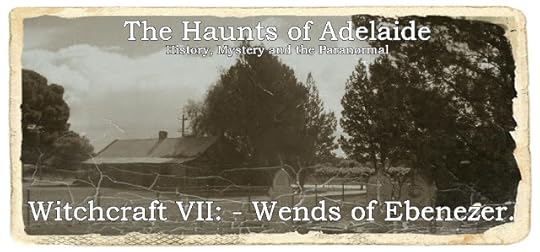
Ebenezer and St Kitts in the Barossa Valley, two small towns that many readers here would probably have never visited, were originally settled by Wendish immigrants. The Wends were a Germanic people from Lusatia in South East Germany. Lusatia was positioned between the German states of Saxony and Brandenburg, and the polish provinces of Lower Silesia and Lubusz and were mainly isolated from other Germans. They were a people closely related to the Serbs, and their language is very similar. (Lusatian’s are sometimes also known as Sorbs or Wends.) Wends were considered a very mystical and spiritual people, and due to historical events like the Thirty-Year War, and the outbreak of the plague, German religious influence crept into the area with many Wends becoming Lutheran (and some Catholic), but the Wends never lost their magical belief.
The Wends, despite being treated poorly by Germans, and often sold into slavery, managed to keep intact their language and many of their customs and beliefs, much of which stayed in place centuries later when they emigrated to South Australia in 1851 and established Ebenezer, St Kitts, Dutton and Neukirch.
It is said that the Wendish people of Ebenezer had access to the book; 'Sixth and Seventh Book of Moses, Magic Sympathetic, Moses, Magic Spirit Master, Mystery of Mysteries.' which supposedly contained the knowledge of witchcraft. The book contained magic spells for healing the sick, invoking spirits, breaking or making curses and other traditional magic. It is believed some of these books may still exist in the area, passed down through families as historical tombs of family knowledge. Witchcraft was part of daily Wendish goings on for families that practiced it, and for those that didn’t, they still bore the superstitions that followed from their homeland, such things as wearing a red ribbon around one’s neck to stop another bewitching them.
One story abounds during the late 1800’s in Ebenezer, which is that of an older woman, who it was said was cursed with immortality and could not die, just age, unless she passed the curse onto someone else. Townsfolk avoided her like the plague, so as not to annoy her and have the curse passed onto them.
A similar version of this immortality curse that surfaced in the area was that those who held the books of Moses could not die, unless they passed those books onto someone else. Just like the old lady, they would age, but not die! Both stories were just folklore used to scare people into not following the traditions of witchcraft.
Other Wendish magical beliefs practiced in the Barossa included baptising infants, so they couldn’t be transformed into Will-o-the-wisps. This magic depended on the Godmother of the child stepping over an axe or broom as they entered the baptismal church.
It was believed witches could become disembodied souls and shapeshift, that they could control animals, especially black dogs and cats. Wends also had traditions from their homeland involving supernatural beings. Some of these included the Pshespoilniza, who would cut the heads of any farmer who did not stop working for an hour at midday. The Wassermann, who was very Bunyip like, was described as a small ugly grey creature with green hair that lived in rivers and ponds that liked to drown people.
Researched and written by Allen Tiller © 2018
Published on October 08, 2018 22:13
October 2, 2018
Witchcraft VI: Koro (Suo-Yang) – Penis Panic
Witchcraft VI: Koro (Suo-Yang) – Penis Panic
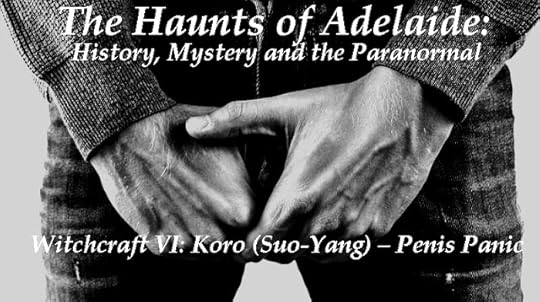
Although this infliction has not occurred in Australia, it has shown up in Africa and China, and originates with witchcraft in Medieval Europe. I thought it was interesting enough to research and write about for the blog, as many people have probably never heard of it before!
Koro, (known as Suo-Yang in China) is psycho-sexual disorder where men become panicked, believing their penis is shrinking, retracting, or completely disappeared.
The Medieval belief of Koro can be found in the fifteenth-century Witch hunting book Malleus Malificarum [Hammer of the Witches] written by Heinrich Kramer and Jacob Sprenger. Within the book, Kramer and Sprenger describe various ways to expose witches, but also a few case studies.
One of the phenomena he claimed was that witches could remove a mans penis, not actually cut off, but remove it with magic.
One of the accounts in Kramer & Sprenger’s book details the story of several witnesses to this very magic.
“What shall we think about those witches who somehow take members in large numbers—twenty or thirty—and shut them up together in a birds' nest or some box, where they move about like living members, eating oats or other feed? This has been seen by many and is a matter of common talk. It is said that it is all done by devil's work and illusion, for the senses of those who see [the penises] are deluded in the way we have said.”
It is claimed that the witches would have up to thirty penises’ in a bird’s nest or box, all wriggling about, and would feed them oats and other grains, treating them as pets.
Kramer and Sprenger’s book was full of misogynist and preposterous accusations against women’s sexuality, that stems from their (and Medieval Christian Europe’s) infatuation and anxieties with women’s sexual desires, sexuality and place in the Bible. The whole basis of his book and accusation against female witches, comes back to one passage which led to countless women being accused of witchcraft, and murdered across the world; "All witchcraft comes from carnal lust, which in women is insatiable.”
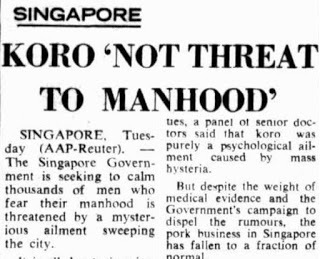 Headline from the Canberra Times
Headline from the Canberra Times
Wednesday 8 November 1967, page 6
(link in the bibliography)Koro, which is a psychological issue, has seen many mass panics in the centuries since the Medieval Witch hunts. In 1967, Singapore was hit with a mass panic, when 454 men visited the Singapore General Hospital over a period on months.
One of the Doctors who treated the men, stated afterwards that patients reported; “a sudden feeling of retraction of the penis into the abdomen with great fear that, should the retraction be permitted to proceed ... the penis would disappear into the abdomen with a fatal outcome.”
The next mass penis-shrinkage-panic happened in China through 1984-1985. Over 3000 individual men were treated for Suo-Yang, weirdly, this time it also included a number of women reporting vulva, labia, nipple and breast shrinkage, or disappearance!
Africa has seen the most recent cases of Koro, with ten years between 1998 and 2008 seeing 56 separate cases. In these cases, the common complaint wasn’t shrinkage, but total loss of penis. 36 people, accused of witchcraft, body part trading, or black mail by penis-snatching were killed in the hysteria that followed accusations over the years.
Zionist Sorcery was apparently the cause of penis-loss in Sudan in 2003. In what was later revealed as an attempt to divert the people’s attention away from what was happening with the presidency.
In 2013, a stranger was visiting a small village in Tiringoulou, Central Africa, when he stopped for a drink. Upon handing the drink to the stranger the vendor suddenly screamed his penis had disappeared, this was soon followed by another villager. Other villagers claimed to see the two men’s penis shrink form adult size to baby size before their eyes! The visitor was duly arrested for sorcery and executed.
Despite the various claims of witchcraft, sorcery and female fox spirits in China stealing penis’s, believe it or not, koro in men and women has a psychological explanation. It would seem in society’s where a person’s reproductive ability helps determine a man’s self-worth, and worth to procreation in their society, are intrinsically connected to anxiety and fear, ethnicity and cultural belief, and political or socioeconomic tension.
Researched and written by Allen Tiller © 2018
https://www.facebook.com/TheHauntsOfA...
Bibliography
Mattelaer, Johan J, Jilek, Wolfgang (2007). "Koro?The Psychological Disappearance of the Penis". The Journal of Sexual Medicine. 4 (5): 1509–1515. doi:10.1111/j.1743-6109.2007. 00586.x.
Smith, M., (2002). “The flying phallus and the laughing inquisitor: Penis theft in the 'Malleus Malificarum'”. Journal of Folklore Research An International Journal of Folklore and Ethnomusicology 39(1):85-117
Edwards, J. W., (1984). “Indigenous Koro, a Genital Retraction Syndrome of Insular Southeast Asia: A Critical Review”. Culture Medicine and Psychiatry 8(1):1-24 · April 1984. DOI: 10.1007/BF00053099
China-Underground. (2016). “Koro, shrinking genitals syndrome”, China-Underground, viewed 13 April 2018, https://china-underground.com/2016/05...
1967 'SINGAPORE KORO 'NOT THREAT TO MANHOOD'', The Canberra Times (ACT : 1926 - 1995), 8 November, p. 6. , viewed 27 Jul 2018, http://nla.gov.au/nla.news-article106...

Although this infliction has not occurred in Australia, it has shown up in Africa and China, and originates with witchcraft in Medieval Europe. I thought it was interesting enough to research and write about for the blog, as many people have probably never heard of it before!
Koro, (known as Suo-Yang in China) is psycho-sexual disorder where men become panicked, believing their penis is shrinking, retracting, or completely disappeared.
The Medieval belief of Koro can be found in the fifteenth-century Witch hunting book Malleus Malificarum [Hammer of the Witches] written by Heinrich Kramer and Jacob Sprenger. Within the book, Kramer and Sprenger describe various ways to expose witches, but also a few case studies.
One of the phenomena he claimed was that witches could remove a mans penis, not actually cut off, but remove it with magic.
One of the accounts in Kramer & Sprenger’s book details the story of several witnesses to this very magic.
“What shall we think about those witches who somehow take members in large numbers—twenty or thirty—and shut them up together in a birds' nest or some box, where they move about like living members, eating oats or other feed? This has been seen by many and is a matter of common talk. It is said that it is all done by devil's work and illusion, for the senses of those who see [the penises] are deluded in the way we have said.”
It is claimed that the witches would have up to thirty penises’ in a bird’s nest or box, all wriggling about, and would feed them oats and other grains, treating them as pets.
Kramer and Sprenger’s book was full of misogynist and preposterous accusations against women’s sexuality, that stems from their (and Medieval Christian Europe’s) infatuation and anxieties with women’s sexual desires, sexuality and place in the Bible. The whole basis of his book and accusation against female witches, comes back to one passage which led to countless women being accused of witchcraft, and murdered across the world; "All witchcraft comes from carnal lust, which in women is insatiable.”
 Headline from the Canberra Times
Headline from the Canberra TimesWednesday 8 November 1967, page 6
(link in the bibliography)Koro, which is a psychological issue, has seen many mass panics in the centuries since the Medieval Witch hunts. In 1967, Singapore was hit with a mass panic, when 454 men visited the Singapore General Hospital over a period on months.
One of the Doctors who treated the men, stated afterwards that patients reported; “a sudden feeling of retraction of the penis into the abdomen with great fear that, should the retraction be permitted to proceed ... the penis would disappear into the abdomen with a fatal outcome.”
The next mass penis-shrinkage-panic happened in China through 1984-1985. Over 3000 individual men were treated for Suo-Yang, weirdly, this time it also included a number of women reporting vulva, labia, nipple and breast shrinkage, or disappearance!
Africa has seen the most recent cases of Koro, with ten years between 1998 and 2008 seeing 56 separate cases. In these cases, the common complaint wasn’t shrinkage, but total loss of penis. 36 people, accused of witchcraft, body part trading, or black mail by penis-snatching were killed in the hysteria that followed accusations over the years.
Zionist Sorcery was apparently the cause of penis-loss in Sudan in 2003. In what was later revealed as an attempt to divert the people’s attention away from what was happening with the presidency.
In 2013, a stranger was visiting a small village in Tiringoulou, Central Africa, when he stopped for a drink. Upon handing the drink to the stranger the vendor suddenly screamed his penis had disappeared, this was soon followed by another villager. Other villagers claimed to see the two men’s penis shrink form adult size to baby size before their eyes! The visitor was duly arrested for sorcery and executed.
Despite the various claims of witchcraft, sorcery and female fox spirits in China stealing penis’s, believe it or not, koro in men and women has a psychological explanation. It would seem in society’s where a person’s reproductive ability helps determine a man’s self-worth, and worth to procreation in their society, are intrinsically connected to anxiety and fear, ethnicity and cultural belief, and political or socioeconomic tension.
Researched and written by Allen Tiller © 2018
https://www.facebook.com/TheHauntsOfA...
Bibliography
Mattelaer, Johan J, Jilek, Wolfgang (2007). "Koro?The Psychological Disappearance of the Penis". The Journal of Sexual Medicine. 4 (5): 1509–1515. doi:10.1111/j.1743-6109.2007. 00586.x.
Smith, M., (2002). “The flying phallus and the laughing inquisitor: Penis theft in the 'Malleus Malificarum'”. Journal of Folklore Research An International Journal of Folklore and Ethnomusicology 39(1):85-117
Edwards, J. W., (1984). “Indigenous Koro, a Genital Retraction Syndrome of Insular Southeast Asia: A Critical Review”. Culture Medicine and Psychiatry 8(1):1-24 · April 1984. DOI: 10.1007/BF00053099
China-Underground. (2016). “Koro, shrinking genitals syndrome”, China-Underground, viewed 13 April 2018, https://china-underground.com/2016/05...
1967 'SINGAPORE KORO 'NOT THREAT TO MANHOOD'', The Canberra Times (ACT : 1926 - 1995), 8 November, p. 6. , viewed 27 Jul 2018, http://nla.gov.au/nla.news-article106...
Published on October 02, 2018 03:00
September 25, 2018
Witchcraft V: Kadina to Hahndorf
Witchcraft V: Kadina to Hahndorf
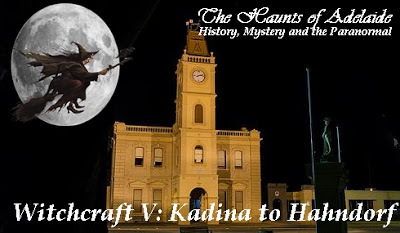
In the town of Kadina, on the Yorke Peninsula in 1874 a find inside a local house led to much local intrigue and excitement. A family bought a house close to the mine and began to move in. While going about their business, they decided to inspect the building as they cleaned it. On looking up into the chimney, the Father discovered two suspended bottles containing water and pins.
The man looked closer in the chimney and soon discovered an old bullocks heart, which was crammed full of pins.
It was thought that the water, heart and pins were an old protection spell to ward of the evils of witchcraft affecting the householders, by suspending it in the chimney, it is thought to have stopped any witches, or their magic entering the house through the chimney opening.Witches were also said to live openly in Hahndorf in the Adelaide Hills. It is claimed an evil witch and a white witch both lived in the town, competing against each other with their various magical wares.
The witches were said to be the reason that some residents in the town began to wear their clothing inside out to ward of evil, and to wear red ribbons for the same reason.
The Hahndorf community chose to commemorate their witchy past with a mural inside the German Arms Hotel that immortalises the two magical folk!
Researched and written by Allen Tiller ©2018https://www.facebook.com/TheHauntsOfA...
Bibliography
Published on September 25, 2018 03:00
September 18, 2018
Witchcraft in South Australia Part IV Gottfried Hoffman
Witchcraft in South Australia Part IV Gottfried Hoffman
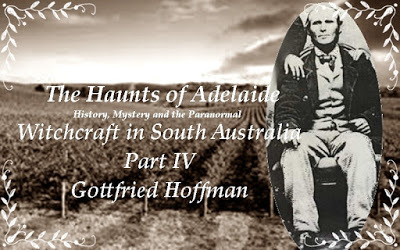
In 1853, Lyndoch cattle and pig farmer, 28-year-old, Gottfried Hoffman was living the simple country life in the Barossa Valley. He had emigrated to Australia from Germany with his wife and family and settled in the predominately German Barossa Valley.
Devoutly Lutheran, Hoffman and family were very well known as they often attended church services at nearby Bethany.
Thing had been going well for the Hoffman family until in late October some his cows and pigs had suddenly, and unexplainably become ill.
On the 5thof November 8-year-old Mary Wressell, a neighbor of Hoffman’s, suddenly turned up on the families’ doorstep. She asked politely for some butter, of which Mrs Hoffman supplied. Before she left Gottfried asked young Mary, if she could please ask her mother to drop by the house. Young Mary returned home to mother (also named Mary) and gave her the butter and message from Mr Hoffman. Mary Ann (mother) finished her chores and went over to the Hoffman house as requested.
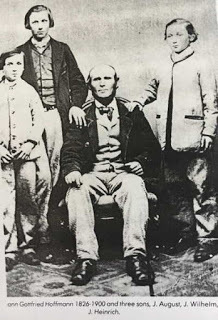 Mary Ann knocked on the Hoffman’s door and was greeted by Mrs Hoffman, who suddenly became hostile and accused May Ann of bewitching the families cows.
Mary Ann knocked on the Hoffman’s door and was greeted by Mrs Hoffman, who suddenly became hostile and accused May Ann of bewitching the families cows.Mary Ann, shocked by the allegation, began to deny any such doing when Gottfried suddenly emerged from the side of the house. He came toward Mary Anne, who held out her hand to shake Gottfried’s hand. Gottfried shook in return, then grabbed Mary Ann’s hand tightly, and slashed across her arm with a large knife.
He rubbed her blood across his hands then stated “mein cows right now.”
Mary Ann cried out in shock and pain, and Gottfried stabbed her in the arm again, then as she twisted to get away he stabbed her twice in the back. He then grabbed a large stick and beat her, before hitting her in the head with a large rock. Mary Ann fell to the ground, but somehow managed to get up and make her way home.
As she stumbled along the path home, she looked back to see Gottfried standing at the front of the house with a shot gun. Mary Ann made it home to her daughter, who raised the alarm with her father that something was wrong. Dr Notts from Gawler was called, and when he arrived, found Mary Ann hysterical. She had wound an inch and half long on her arm that went through to the bone, and two stab wounds on her back and shoulder. She was also badly beaten and covered in bruises.
Gottfried was soon arrested and charged with cutting, maiming and assaulting Mary Ann Wresell. During the court case Hoffman’s wife and brother’s testimony conflicted with that of Wresell, but the evidence was overwhelming, and the jury found him guilty. Hoffman was sentenced to 5 years hard labour.
Curiously, during the entire court case, Hoffman did not deny his belief that Mary Ann Wessell was a witch that had hexed his farm, and that washing his hands in her blood would cure the families problems!
Researched and written by Allen Tiller ©2018https://www.facebook.com/TheHauntsOfA...
Bibliography
1854 'WITCHCRAFT IN SOUTH AUSTRALIA.', Inquirer (Perth, WA : 1840 - 1855), 8 March, p. 2. (SUPPLEMENT TO "THE INQUIRER."), viewed 09 Apr 2018, http://nla.gov.au/nla.news-article65741753
1853 'LAW AND POLICE COURTS. SUPREME COURT—CRIMINAT, SIDE.', Adelaide Times (SA : 1848 - 1858), 3 December, p. 3. , viewed 09 Apr 2018, http://nla.gov.au/nla.news-article207121817
1854 'WITCHCRAFT IN SOUTH AUSTRALIA.', Inquirer (Perth, WA : 1840 - 1855), 8 March, p. 2. (SUPPLEMENT TO "THE INQUIRER."), viewed 09 Apr 2018, http://nla.gov.au/nla.news-article657...
Published on September 18, 2018 03:00
September 11, 2018
Witchcraft in South Australia: Part III: Australian Laws
Witchcraft in South Australia: Part III: Australian Laws
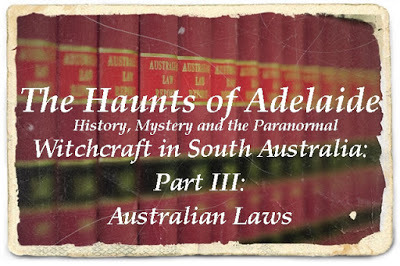
Last blog we looked at Witchcraft laws around the world, this week we will be looking at the Australian States and Territories and laws regarding witchcraft that have been repealed or are still in place.
New South Wales
The Witchcraft Act of 1735 was repealed by the Imperial Acts Application Act, 1969 (NSW),
The offence of fortune telling, [Section 4(2)(n) of the Vagrancy Act, 1902 (NSW)] was repealed by the Summary Offences Act (Repeal) Act, 1979 (NSW). New South Wales currently has no Witchcraft Act.
Northern TerritoryThe Northern Territory still had The Witchcraft Act of 1735 (9 Geo. 2 c. 5) as law as late as 2013. (Smail, 2013). The Act was repealed and replaced under the Summary Offences Act 2016 57(1)(d). In the Northern Territory Act, a person commits an offence if they pretend to “…tell fortunes, or uses any subtle craft, means, or device, by palmistry or otherwise, to deceive and impose upon a person”. (NT Gov. 2016).
Queensland Witchcraft in Queensland was covered in The Criminal Code -Section 432, which stated; "Any person who pretends to exercise or use any kind of witchcraft, sorcery, enchantment, or conjuration, or undertakes to tell fortunes, or pretends from his skill or knowledge in any occult science to discover where or in what manner anything supposed to have been stolen or lost may be found, is guilty of a misdemeanour, and is liable to imprisonment for one year." However, the code was changed in 2005, and “witchcraft” perse, is not mentioned, however via invoking Public Nuisance laws, psychics committing fraud can still be charged with a crime.
South Australia
The Statutes Amendment and Repeal (Public Offences) Act, 1991 abolished the Witchcraft laws in SA.
However, the 1991 Act came with a new section, Section 40. A person who, with intent to defraud purports to act as a spiritualist or medium or to exercise powers of telepathy or clairvoyance or other similar powers, is guilty of an offence.
VictoriaVictoria was the last Australian State to repeal a witchcraft act, which happened in 2005 with the "Vagrancy (Repeal) and Summary Offences (Amendment) Act 2005", prior to this repeal the law in Victoria Stated:
Section 13 of the Vagrancy Act 1958 which is entitled 'Fortune Telling and Pretending to Exercise Witchcraft, etc':
Any person who pretends or professes to tell fortunes or uses any subtle craft means or device by palmistry or otherwise to defraud or impose on any other person or pretends to exercise or use any kind of witchcraft sorcery enchantment or conjuration or pretends from his skill or knowledge in any occult or crafty science to discover where or in what manner any goods or chattels stolen or lost may be found shall be guilty of an offence. (AAP, 2005)
Tasmania, Western Australia and the ACT have no laws against witchcraft.
Researched and written by Allen Tiller © 2018https://www.facebook.com/TheHauntsOfA...
Bibliography
AAP, 2005, Victoria clears witches for take-off, Fairfax Media, viewed 9 April 2018, https://www.theage.com.au/news/Nation...
Smail, S, 2013, Northern Territory government to repeal centuries-old witchcraft, tarot card law, ABC News, viewed 9 April 2018, http://www.abc.net.au/news/2013-08-17...
Northern Territory Government, 2016, Legislation, NT Government, viewed 9 April 2018, https://legislation.nt.gov.au/Legisla...
Published on September 11, 2018 03:00
September 4, 2018
Witchcraft in South Australia Part II: Witchcraft Laws Around the World.
Witchcraft in South AustraliaPart II:Witchcraft Laws Around the World.
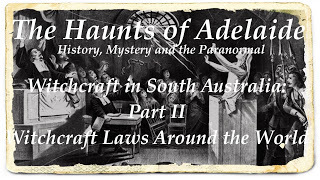
Last blog I introduced a very brief history of witchcraft persecutions across the world. There is much more I could say, but this isn’t the blog to do so. This week, I am going to cover some of the laws pertaining to the practice of witchcraft across the world, many or which have been repealed, but others remain intact, some in countries you would not suspect! Ye Olde witch, ‘malefici’ (male) or ‘maleficae’ (female) was thought to be a devil worshipping practitioner, or in league with the devil to gain something for themselves. They were everyday people who were accused of witchcraft for political or social gain, or because they didn’t conform to someone else’s religious views, or sometimes it was purely for how they looked.
1542In Britain and the English Isles, accusations of witchcraft were rife. In 1542, Henry VIII introduced the Witchcraft Act 1542 (33 Hen. VIII c.8) which was the first law to define witchcraft as a punishable felony. A witch found guilty could face a punishment of death or forfeiture of goods and chattels. It also removed the right to “benefit of clergy”, which was a legal device that anyone that could read a passage form the bible, would be spared from death by hanging.
1563Elizabeth 1 was next to make laws in England directed at witchcraft with the release of “Act against Conjurations, Enchantments and Witchcrafts. (5 Eliz. I c. 16).” Within her new laws, Elizabeth 1 decreed that anyone who should "use, practise, or exercise any Witchcraft, Enchantment, Charm, or Sorcery, whereby any person shall happen to be killed or destroyed" would forego the benefit of clergy and be put to death.
However, for lessor charges of witchcraft, where a person, wasn’t not seriously hurt or killed, imprisonment was the preferred option.
The same year the Scottish Witchcraft Act was set in place. This act established that both the practice of witchcraft and consulting witches were felonious offences punishable by death. It did not clearly define what witchcraft was, nor how to identify a witch. (Moir, 2014)
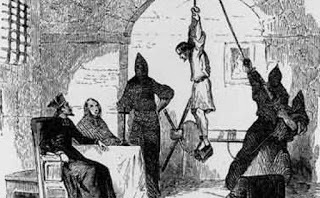
1604 James I was next to add witchcraft laws with; “An Act Against Conjuration, Witchcraft and dealing with evil and wicked spirits”. James' I, act broaden the scope of the act that anyone who practiced
1649The Scottish Witchcraft Act of 1649 expanded on some aspects of the previous, Witchcraft Act of 1563, by passing laws to enforce acts of godliness. It now became illegal to worship false idols, be guilty of blasphemy and curse parents. It also enabled a new clause that allowed the death penalty for consulting with witches, devils or “familiar spirits”.
1735With the passing of The Witchcraft Act of 1735 (9 Geo. 2 c. 5) previous acts in England and Scotland were repealed and replaced under the one Act. The new act took away the death penalty for guilty parties, and instead enforced fines and imprisonment.
The scope of “witchcraft” was broadened to become more inclined to represent those who claimed to be psychic. Any person who claimed to be able to tell the future, convene or talk with spirits, cast spells or various other acts could be arrested, fined and imprisoned.
This is the act under which Helen Duncan was found guilty of witchcraft in 1944.
The act remained current until 1951, when it was replaced with the Fraudulent Mediums Act of 1951.
The Fraudulent Mediums Act of 1951 was repealed in 2008 and replaced by consumer protection regulations.
South Africa still enforces The Witchcraft Suppression ACT, 1957, which was based on the Witchcraft Act of 1753. (Juta and Company, Ltd., 2005.)
This act states items such as Causing disease or injury to another person or thing, by supernatural means, indicating one is a wizard, or professing to use supernatural powers, witchcraft, sorcery, enchantment or conjuration shall be liable for a conviction can imprisoned for 20 years.
Any person who employs a witchdoctor, witch-finder or professes to be a wizard can be fined five hundred Rand or imprisoned for a maximum of 5 year, or both.
Anyone who pretends to use any supernatural power, witchcraft, sorcery, enchantment or conjuration, or undertakes to tell fortunes, or pretends from his skill in or knowledge of any occult science to discover where and in what manner anything supposed to have been stolen or lost may be found guilty and face a fine of two hundred Rand or two years imprisonment. The South African Act was then Amended in 1970 to repeal the 3rd act of the to now read;
“To amend the Witchcraft Suppression Act, 1957, so as to make it an offence for a person who pretends to exercise supernatural powers, to impute the cause of certain occurrences to another person; and to provide for incidental matters.”The South African witchcraft act is still enforceable to this day.
Next week we will explore current Australian laws regarding witchcraft.
Researched and written by Allen Tiller © 2018https://www.facebook.com/TheHauntsOfA...
References
Goodare, Julian. “The Scottish Witchcraft Act.” In Church History, 39-67. Cambridge: Cambridge University Press, 2005.
Juta and Company, Ltd.,2005, WITCHCRAFT SUPPRESSION ACT 3 OF 1957, Juta and Company, Ltd. viewed 9 April 2018, http://www.justice.gov.za/legislation/acts/1957-003.pdf
Moir, S, 2014, Scottish act of 1563, Washington and Lee University, viewed 9 April 2018, https://witchhunts.academic.wlu.edu/2014/12/09/scottish-act-of-1563/
Rosen, Barbara & Rosen, Barbara, 1929- 1969, Witchcraft, Edward Arnold, London
Published on September 04, 2018 03:00
August 28, 2018
Witchcraft in South Australia: Part I The Hammer of the Witches.
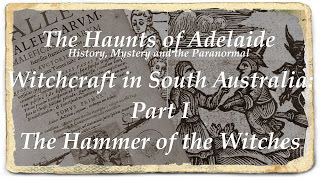
Over the coming weeks I will be looking into crimes in South Australia relating to Witchcraft, but before we get to those cases, I thought it best to establish some background on the persecution of Witches around the world, which was predominately focussed on women in most countries.
Witchcraft – the word conjures up images of, cauldrons, green skinned women riding on brooms, and women being burnt at the stake. Many people also associate witchcraft with the Salem, Massachusetts witch trials in 1692/93, but don’t know that the trials were much further widespread at the time, with many scholars agreeing that in the one hundred years between 1600 to 1700, somewhere between 100,00 and 200,00 people were tried for witchcraft across Europe, and between 40, 000 to 60, 000 people were executed for the crime. (Wiesner-Hanks, 2006)Back in those days there were two basic claims associated with being a witch, performing harmful or evil magic, known as its Latin name; Maleficia and directly making a pact with the devil known as Maleficium. Male practitioners of witchcraft were known as ‘malefici’ and female practitioners witchcraft were known as ‘maleficae’. [in Latin the terms are maleficia = evil deeds; maleficium = evil deed].
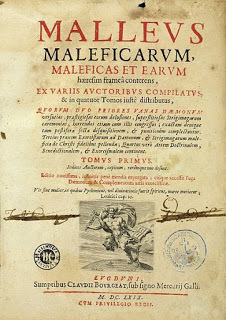 In South America, many women fled into the mountains to avoid slavery from the Spanish who were entering South America under the guise of “spreading the word of God”. These women were sometimes captured, and because they would not yield to their Spanish captors and take the word of the Lord (A God and religious system they had never heard about) they would be tried as witches, and often they were executed. We don’t hear much about people being persecuted for witchcraft nowadays in the Western World, as most countries have repealed their witchcraft laws, but as late as 1944, 3 women were sentenced in the UK for breaking the law, with one, Mrs Helen Duncan considered the last of the Witch Trials.
In South America, many women fled into the mountains to avoid slavery from the Spanish who were entering South America under the guise of “spreading the word of God”. These women were sometimes captured, and because they would not yield to their Spanish captors and take the word of the Lord (A God and religious system they had never heard about) they would be tried as witches, and often they were executed. We don’t hear much about people being persecuted for witchcraft nowadays in the Western World, as most countries have repealed their witchcraft laws, but as late as 1944, 3 women were sentenced in the UK for breaking the law, with one, Mrs Helen Duncan considered the last of the Witch Trials. Duncan had come under scrutiny after making claims about a sailor on a sunken British ship. The sinking of the ship had never been made public, so she drew the attention of military officials, who after testing her abilities, concluded she was a fake. She was charged with two counts of conspiring to contravene the Witchcraft Act, two counts of obtaining money by false pretenses, and three counts of public mischief – she was sentenced to nine months imprisonment. (News, 1944).
Modern Witchcraft, sometimes called Wicca or “The Craft” is very different to the witchcraft of old. Modern witchcraft concerns mainly the worship of the Goddess, and many following this interpretation of witchcraft see themselves as healers or helpers, and often takes from various pagan beliefs that have before them such as shamanism and druidism.
In the next blog we will look at the various Witchcraft Acts around the world, some of which still apply to this very day!
Researched and written by Allen Tiller © 2018https://www.facebook.com/TheHauntsOfAdelaide/
Bibliography
Merry E. Wiesner-Hanks, Early Modern Europe 1450-1789 (Cambridge and New York, 2006), pp. 386-93.
WITCHCRAFT. (1853, December 10). Adelaide Observer (SA : 1843 - 1904), p. 1 (Supplement to The Adelaide Observer.). Retrieved April 9, 2018, from http://nla.gov.au/nla.news-article158095751
1944 'Medium in "Ghost" Trial Gets 9 Months' Gaol', News (Adelaide, SA : 1923 - 1954), 4 April, p. 5. , viewed 09 Apr 2018, http://nla.gov.au/nla.news-article128...
Published on August 28, 2018 03:00
August 21, 2018
"Gawler" by La Journie, 1930
"Gawler" by La Journie, 1930
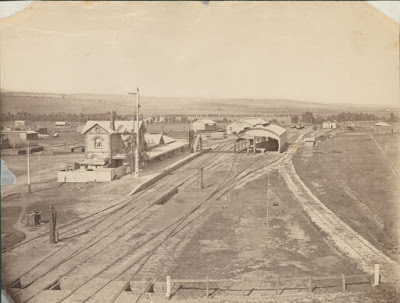 SLSA: B 11491
Gawler Railway Station
opened in 1857 and the original platform building was replaced in 1879
SLSA: B 11491
Gawler Railway Station
opened in 1857 and the original platform building was replaced in 1879Every so often whilst carrying out my research I come across delightful titbits about towns or people, generally in the “Letters to the Editor: section of old newspapers. The following poem I found amusing, as I had been researching the building of the Gawler Town Clock, and the animosity from townsfolk regarding its inability to keep time.
Also, as a born and bred Gawlerite, I can remember older folk than me calling Gawler Antiquated”, so the following poem, with its stinging satire and cynicism amused even more so!Enjoy!
GAWLER.
A Doggerel.Sleepy country townEyeing, with a frown,Anything approaching real progression.Up and down the place,Filling all the space,Are oddities that show its retrogression.
Every passing hour,From the town clock tow'r,The chimes ring out their merry melody :Yet often in the nightFrom the tower's height,Come fifteen chimes instead of only three.
Unhappily for youShould your watches be untrue.Any evening at all in this quaint town.You'll find the clock alright,But they haven't got a light,And the dial is as dark as Pluto's crown .
To the station if you'd travel,There's a mystery to unravel :How to get there is the thing you want to know.Prop a post up with your shoulderTill you see a waggon olderThan the buckboards of a century ago.
Start to shout, and do a dance,Anything that will enhanceA wild Red Indian attitude, or fierce Berseker air-.Then the wagon gives a bound.Sways, and turns two-thirds around —And the tramcar has another fourpenny fare.
Finally the most amusing.Is the crowd that stand enthusingIn the middle of the street on Friday night. .So antiquated Gawler,Lest you grow any smaller,Just eradicate self-satisfaction's blight.
'La Journie.'
1930 'GAWLER.', Bunyip (Gawler, SA : 1863 - 1954), 31 January, p. 10. , viewed 04 Jul 2018, http://nla.gov.au/nla.news-article966...
Published on August 21, 2018 03:00
August 7, 2018
Gawler’s Hidden Secrets: The Gawler Clock Tower
Gawler’s Hidden Secrets: The Gawler Clock Tower
<Transcipt>
In 1878, the end of the world rung out from the Gawler Post Office Clock Tower, or so local Gawlerites thought, when the clocks bell rang 100 times in a row, plenty said their prayers that night, only to wake the next day to another winters day.
The Gawler Town Clock committee was first formed in 1867, with the intent to buy and install a town clock in the tower of the main street post office. Wednt’s Jewellers of Rundle Street, Adelaide supplied the clock, four dials made of milk glass, spanning three feet and six inches in diameter. On the 6th of September 1867, the Mayor of Gawler as well as Mr Wendt and a few councillors went into the clock tower, and a few minutes before 4pm, set the pendulum in motion. At 4pm that day, the clock struck the hour on time…which over the coming years, the clocks lack of time keeping would be a major issue and the butt of many jokes by townsfolk.
The clock was originally powered by two weights suspended on cables, which are wound on drums, attached to the clock mechanism. These cables had to be manually wound once a week.The clock mechanism was converted to electric winding and was maintained with biennial visits by a company called Adelaide Clock and Parts Supplies. Throughout the years, it was often noted that the Gawler town clock was hardly able to keep time. One young police officer noted it could be up to four minutes slower than the clock at the Gawler Railway Station!
In 1998, Gawler watchmaker Mr Kaesler took over the winding duties of the clock, and also regular maintenance.
At Mr. Kaesler's suggestion a clock tower committee was formed, to restore and maintain the clock.
“The Friends of the Clock Tower” began in March 2002 and continues to this day.
The Friends of the Clock Tower were also responsible for returning the clock to its former hand wound glory, removing the electric winder, restoring broken parts, and replacing broken glass. An interesting piece of Gawler Trivia is a mistake on the clock, which lies on the eastern side, which if you go up into the Target carpark and look across you can see for yourself. on the eastern face, which shows, written in Roman Numerals a four is where the six should be!
P.S. there are actually 2 mistakes on the clock, the second mistake being that The Roman Numeral for “Four” is “IV” not IIII as marked on the clock faces.
You can also find more of Allen’s work on his Blog and facebook on the links below: Blog: http://hauntedadelaide.blogspot.com/
Facebook:
https://www.facebook.com/TheHauntsOfAdelaide/?ref=bookmarks
https://www.facebook.com/AllenHauntingAustralia/
For More history on the Town of Gawler, please visit the Gawler History Team page “Gawler: now and Then” at: http://www.gawler.nowandthen.net.au/M...
Published on August 07, 2018 03:00
July 30, 2018
Gawler’s Hidden Secrets: Goose Island
Gawler’s Hidden Secrets: Goose Island
<Transcript>
Once known as Duck Flat, Gawler’s Goose Island is little known outside of the town.At the end of 8th street, which was known as Water Street, sits the parkland which was once home to Chinese’s market gardeners.Parts of the land were originally owned by local Gawler identity, Mr James Martin, who is often referred to as “The Father of Gawler”, as his foundry helped employ many locals and brought industry and commercial growth to the town.
Goose Island, which sits about four meters below the level of the rest of the town, and lower than the eastern river bank, is prone to flooding. Before a swing bridge was built in 1889, residents had to navigate the river bed, and then climb the riverbank to get to Whitelaw Terrace and the rest of the town.
In 1865, Goose Island was used for sporting events. One such event was between Gawler’s H. Ortel and Kapunda’s Abel Marryat, who were sprinting against each over for the princely winnings of $40 pounds. Marryat won the races easily. As Gawler grew, people began to build on Goose Island, and soon many residents had little cottages surrounded by pig sties and chicken coops. In 1885, a Typhoid outbreak hit Goose Island, thought to be due to the unsanitary conditions being caused by stagnant water in the river. A few residents died, but the outbreak was contained quickly.
An attempt to damn the river to allow people to swim or boat on the south para lasted only a short while around the early 1900’s, with a downpour of rain soon cutting a new channel around the dam. The dam was eventually blown up with dynamite in the late 1930’s.In 1899 the first swing bridge spanning from Goose Island to Walker Place was built. Unfortunately, as the South Para river was prone to extensive flooding every winter, the bridge was washed away only a year later.
The bridge had to be built many times over the years, as flooding almost every winter, saw it destroyed.
It wasn’t until the late 1920’s that council found a solution for the bridge being washed away, and instead of just building a rope style swing bridge, or a reinforced wire swing bridge, it was decided to sink railway line in concrete in the base of the river to offer more stability, then add steel cable anchored on the riverbanks. This bridge lasted until 1937, when it was washed away again!
Not far from the swing bridge of Goose Island, a little area was set aside as a reserve for children to play. Water was diverted around the play area, which was adjacent to Walker Place creating a small island, the island itself covered with sand.
Children often played here unsupervised, which led to the tragic death of 12-year-old Flora Kamprod on the 16th of July 1927. Flora had been playing in the sand with several friends, who had dug a tunnel, and a large chamber. The chamber and tunnel collapsed burying four children, with Flora being completely buried inside. A mad rush to get helped followed, but it was too late for young Flora who suffocated under the sand.Flora wasn’t the only tragedy near Goose Island, in 1892, Willie Sampson, aged nine years, drowned in the river. Willie was playing with friends and dove into the water, and possibly hit his head on a submerged branch, and then got stuck.
The two other boys called out for help, and it took two passers-by over an hour before they could pull Willie from the river…
In 1951, Goose Island was again covered in water, this time flooding the gardens of local business owner Mr Noack. Noack lost 3000 poppies, 4000 gladioli and other bulbs, but considered the damage only slight to his business.
In 1985, Goose Island flooded again, but the bridge, built in the 1960’s withheld the raging torrent. Again, the river flooded in 2005, this time flooding well up into 8th street, but still the bridge survived!
Today, Goose Island is a reserve right in the heart of Gawler that may soon become another car park to meet the growing needs of the town. It will be interesting to see what artefacts are found if the proposed carpark for goose Island goes ahead.
<End Transcript>
You can also find more of Allen’s work on his Blog and facebook on the links below: Blog: http://hauntedadelaide.blogspot.com/
Facebook:
https://www.facebook.com/TheHauntsOfAdelaide/?ref=bookmarks
https://www.facebook.com/AllenHauntingAustralia/
For More history on the Town of Gawler, please visit the Gawler History Team page “Gawler: now and Then” at: http://www.gawler.nowandthen.net.au/M...
Published on July 30, 2018 19:22



